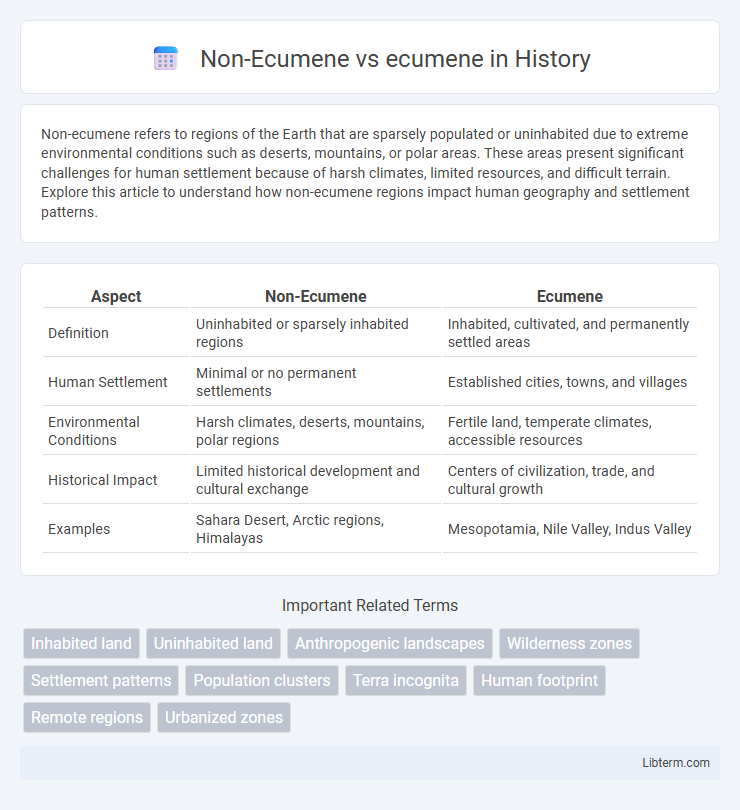Non-ecumene refers to regions of the Earth that are sparsely populated or uninhabited due to extreme environmental conditions such as deserts, mountains, or polar areas. These areas present significant challenges for human settlement because of harsh climates, limited resources, and difficult terrain. Explore this article to understand how non-ecumene regions impact human geography and settlement patterns.
Table of Comparison
| Aspect | Non-Ecumene | Ecumene |
|---|---|---|
| Definition | Uninhabited or sparsely inhabited regions | Inhabited, cultivated, and permanently settled areas |
| Human Settlement | Minimal or no permanent settlements | Established cities, towns, and villages |
| Environmental Conditions | Harsh climates, deserts, mountains, polar regions | Fertile land, temperate climates, accessible resources |
| Historical Impact | Limited historical development and cultural exchange | Centers of civilization, trade, and cultural growth |
| Examples | Sahara Desert, Arctic regions, Himalayas | Mesopotamia, Nile Valley, Indus Valley |
Introduction to Ecumene and Non-Ecumene
Ecumene refers to the inhabited, permanently settled regions of the Earth where human activity thrives, characterized by urban development, agriculture, and infrastructure. Non-ecumene encompasses uninhabited or sparsely populated areas such as deserts, mountains, polar regions, and dense forests that lack sustainable human settlements. Understanding the distinction between ecumene and non-ecumene aids geographic and demographic studies, highlighting patterns of human habitation and environmental limitations.
Defining Ecumene: The Inhabited World
Ecumene refers to the regions of the Earth that are permanently inhabited and suitable for human settlement, encompassing urban centers, agricultural lands, and developed areas where population density is sustainable. Non-Ecumene represents the uninhabited or sparsely populated zones, often characterized by extreme climates, harsh terrain, or limited resources such as deserts, polar regions, and dense forests. Understanding the distinction between ecumene and non-ecumene is essential for studying human geography, resource distribution, and patterns of civilization development.
Non-Ecumene: Understanding Uninhabited or Sparsely Populated Areas
Non-ecumene refers to regions of the Earth's surface that remain uninhabited or sparsely populated due to harsh environmental conditions such as extreme cold, arid deserts, dense forests, or high mountainous terrain. These areas, including the Sahara Desert, Arctic tundra, and Amazon Rainforest, present significant challenges to sustained human settlement and agriculture, limiting population density and development. Understanding non-ecumene zones is crucial for geographers and urban planners when assessing human distribution patterns and potential zones for future habitation.
Historical Evolution of the Ecumene Concept
The concept of ecumene historically evolved from ancient Greek geography, where ecumene referred to the known inhabited world, contrasting with non-ecumene areas perceived as unknown or uninhabitable. Over time, advancements in exploration and cartography during the Age of Discovery redefined ecumene to include broader human settlements, shrinking the non-ecumene zones significantly. Modern geographical and anthropological studies emphasize ecumene as regions continuously inhabited and culturally developed, while non-ecumene denotes sparsely populated or environmentally extreme areas.
Geographic Distribution of Ecumene Regions
Non-ecumene regions consist of sparsely inhabited areas characterized by extreme climates such as deserts, polar regions, and dense rainforests, which limit human settlement due to harsh environmental conditions. Ecumene regions, by contrast, are predominantly located in temperate zones with fertile soils, abundant freshwater, and favorable climates that support dense populations and extensive agriculture, exemplified by areas like Europe, the Indian subcontinent, and the Nile River Valley. The geographic distribution of ecumene reflects the interplay of natural resources, topography, and climate that collectively facilitate sustained human habitation and cultural development.
Factors Influencing Non-Ecumene Zones
Non-Ecumene zones, characterized by sparse or no human habitation, are influenced by harsh environmental factors such as extreme climates, rugged terrains, and limited water resources, which hinder agricultural and urban development. These regions often exhibit high altitudes, dense forests, deserts, or tundra conditions, creating physical barriers for sustainable settlements and economic activities. In contrast, Ecumene areas present favorable geographic and climatic conditions that support dense populations, intensive agriculture, infrastructure, and economic growth.
Human Adaptation: Expanding the Ecumene
Human adaptation plays a critical role in transforming non-ecumene, regions initially uninhabitable due to extreme climates or terrain, into ecumene, or permanently settled areas. Advances in technology, infrastructure, and resource management enable humans to overcome environmental challenges, facilitating expanded habitation in deserts, arctic zones, and high-altitude regions. This continuous expansion of the ecumene reflects the dynamic interaction between human innovation and natural constraints, reshaping global population distribution.
Environmental Challenges in Non-Ecumene Areas
Non-ecumene areas, characterized by extreme climates, sparse vegetation, and limited water resources, face significant environmental challenges such as soil erosion, desertification, and biodiversity loss. Harsh conditions hinder sustainable agriculture and infrastructure development, exacerbating human vulnerability and disrupting ecological balance. Conservation efforts prioritize adaptive strategies like water management, reforestation, and habitat restoration to mitigate degradation in these fragile landscapes.
Socioeconomic Impacts of Ecumene vs Non-Ecumene
Ecumene regions, characterized by dense populations and developed infrastructure, drive economic growth through concentrated industry, services, and innovation hubs, fostering higher employment rates and improved living standards. Non-ecumene areas, often marked by sparse populations and limited infrastructure, experience slower economic development, reduced access to healthcare and education, and higher poverty levels due to geographic isolation and limited resource allocation. The socioeconomic divide between ecumene and non-ecumene zones impacts migration patterns, resource distribution, and policy focus, emphasizing the need for targeted regional development strategies.
Future Prospects: Shifting Boundaries of Human Habitation
Non-ecumene regions, characterized by extreme climates, limited resources, and inhospitable terrains, are gradually becoming accessible due to advancements in technology, climate adaptation, and sustainable development. Future prospects suggest a potential expansion of human habitation into previously uninhabitable areas such as polar zones, deserts, and high-altitude regions, driven by innovations in infrastructure and environmental management. Ecumene areas, meanwhile, are expected to face pressures from urbanization and climate change, prompting a dynamic redefinition of the boundaries between settled and unsettled lands.
Non-Ecumene Infographic

 libterm.com
libterm.com